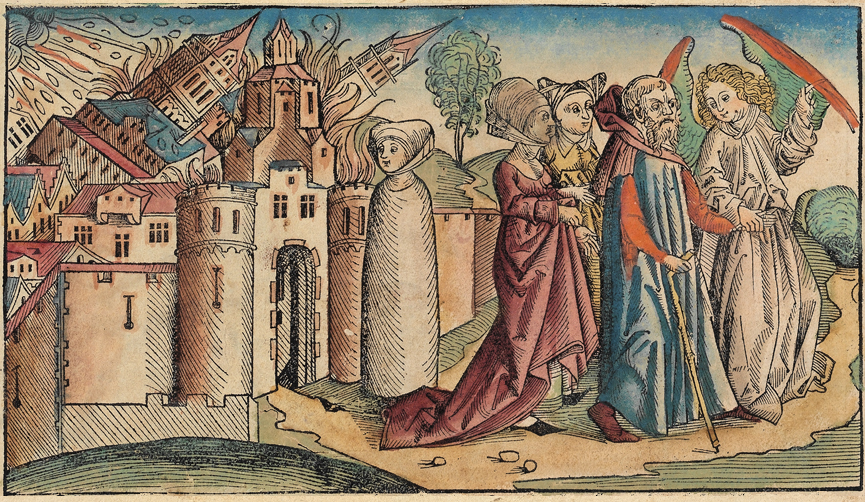In one of the Bible’s scariest stories, God pours fire and brimstone upon Sodom and surrounding cities in punishment for their wickedness.
Amazingly, it now turns out that the story may be based on something that actually happened more than three and a half millennia ago.
Over the last fifteen years, archeologists have been excavating a site in the Jordan Valley, north of the Dead Sea, known as Tall el-Hammam (https://tallelhammam.com). In the Middle Bronze Age (starting around 1950 BCE), it was a major fortified city, one of the largest in the region (much larger, for example, than Jerusalem and Jericho). Around 1650 BCE, it was abruptly destroyed and abandoned for more than 600 years.
In a study that has just been published in Nature (https://www.nature.com/articles/s41598-021-97778-3), a highly respectable and prestigious journal, a group of scientists concludes, after analyzing the pattern of the destruction at Tall el-Hammam and the chemical composition of the debris, that the city was leveled and incinerated by a 12+ megaton airburst, likely caused by disintegration of a large meteorite. Similar events took place in the basin of the Podkamennaya Tunguska river in Siberia in 1908 and (on a much smaller scale) over the Russian city of Chelyabinsk in 2013. It has also been suggested that the Paleolithic site of Abu Hurayra in present-day Syria was destroyed by a comet explosion some 12,800 years ago (https://www.nature.com/articles/s41598-020-60867-w).
To the survivors, such a blast would look and feel like fire and molten rock pouring upon the city from heavens.
We do not know if the city’s name was Sodom, as it is not mentioned in any extant written sources. But it could well be.
What it could not be is Sodom as the Book of Genesis describes it. And that tells volumes about the origins of the biblical text.
In Genesis 18:16, the angels who had just visited Abraham and Sarah and told them that they would finally have a child depart in order to head for Sodom, and Abraham walks with them part of the way. God reveals to him that Sodom is to be destroyed (verses 17-22). Abraham tries to intercede for the city, and God promises to spare it if ten righteous persons are found there (verses 23-33). It turns out that all Sodomites are wicked, and fire and brimstone ensue. In the morning, Abraham returns to the place where he had spoken with God, looks at Sodom, Gomorrah, and surrounding cities, and sees “smoke rising from the land, like furnace smoke” (Genesis 19:27-28).
Abraham and his family live at this point in the terebinth grove of Mamre (Genesis 18:1), near the city of Hebron (Genesis 13:18; 23:19; 35:27). Tall el-Hammam, located northeast of the mouth of the Jordan river, is about 33 miles (53 kilometers) away as the crow flies. Taking into account the rugged terrain, it would take Abraham a strenuous hike of several days to reach a point from which he could look down at Tall el-Hammam. From a place to which he could casually walk twice in two days from Hebron (Genesis 18:6; 19:27) he most likely would not be able to see even a column of smoke rising over the distant horizon. (He would most certainly hear and feel a 12+ megaton detonation but the Bible is silent on that.)
What is indeed visible from multiple points in the area of Hebron is the central part of the Dead Sea. Incidentally, this is where salt formations can be found, one of which in ancient times could resemble a woman with her head turned back (Genesis 19:26). There are no such formations north of the sea, where Tall el-Hammam is situated.
In short, the Bible visualizes Sodom as located dozens of miles south of the spot where according to the Nature article the airburst occurred around 1650 BCE.
That means the author of the biblical account lived much, much later – in accordance with the findings of my book, The Man Who Wrote the Bible, where I argue that the author of Genesis-Kings was born around 625-630 BCE and died after 560 BCE.
If Tall el-Hammam was indeed obliterated by a meteorite explosion, the tremendous event could be remembered for many generations, but specifics would fade over time. It is quite possible that the biblical author was familiar with a story of fire raining upon a city. Maybe the tradition even called it Sodom. But it was extremely vague on the city’s location, suggesting only that it sat somewhere at the bottom of the Jordan Valley – Dead Sea rift.
With the chaotic, craggy terrain surrounding the southern part of the Dead Sea much more suggestive of a past upheaval than the relatively placid Jordan Valley, the biblical author chose the former as the backdrop of the drama.
And that gives us a glimpse into the kitchen where the Grand History that is Genesis-Kings was cooked.
Some parts of it – especially the books of Samuel and Kings, covering the period when Israel was a monarchy – may be based on contemporary documents (although I doubt very much that any of these documents was included verbatim). But earlier events were chronologically so distant from the author’s time that written records were no longer available – if they ever existed. For these parts of the narrative, the author had either to use his own fertile imagination or to rely on literary sources, such as ancient Near Eastern (especially Mesopotamian) mythology and oral traditions. These were chosen not for their veracity – which was impossible to determine – but rather for their utility in making a point.Today we know that the tale of fire raining down from heaven upon a city may be rooted in an actual event. But the biblical writer had no way of knowing it – and most likely, he could not care less. What mattered for him was that the tale gave him an opportunity to demonstrate God’s awesome might and lack of patience with evildoers, especially those who challenge his authority by trying to rape his messengers. The writer seized this opportunity and deployed it so brilliantly that even today, two and a half thousand years down the road, the story of Sodom’s destruction continues to reverberate in our imagination.

